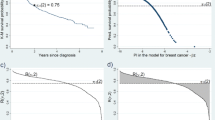Abstract
In clinical studies, patients are often classified into high or low risk groups based on prognostic factors related to survival outcomes. Using maximally selected linear rank statistics, several methods have been developed to determine a cutoff value of the prognostic factor. We propose an extension of these methods for the circumstances that competing risks are encountered in conjunction with an event outcome of interest. A simulation study is carried out to demonstrate the performance of the proposed method using some commonly used measures such as bias, precision, and power. We also apply our method to two real datasets involving lung cancer and hepatocellular carcinoma, illustrating optimal determinations of cutoff values for binary decisions on prognosis.






Similar content being viewed by others
References
Billingsley P (1999) Convergence of probability measures, 2nd edn. Wiley, New York
Contal C, O’Quigley J (1999) An application of change point methods in studying the effect of age on survival in breast cancer. Comput Stat Data Anal 30:253–270
Cox DR (1975) Partial likelihood. Biometrika 62:269–276
Gray RJ (1988) A class of K-sample tests for comparing the cumulative incidence of a competing risk. Ann Stat 16:1141–1154
Hothorn T, Zeileis A (2008) Generalized maximally selected statistics. Biometrics 64:1263–1269
Hrick DE, Schulak JA (1998) Steroid withdrawal from cyclosporine-based regimens: con—a flawed strategy. Transplant Proc 30:1785–1787
Jespersen NCB (1986) Dichotomizing a continuous covariate in the Cox regression model. Research Report 86/2. Statistical Research Unit, University of Copenhagen
Kalbfleish JD, Prentice RL (2002) The statistical analysis of failure time data, 2nd edn. Wiley, New York
Kaplan EL, Meier P (1958) Nonparametric estimation from incomplete observations. J Am Stat Assoc 53:457–481
Kim SW, Park CK (2002) Categorizing tumor size as a prognostic factor for risk of relapse of hepatocellular carcinoma. Korean J Appl Stat 15:1–8
Klein JP, Moeschberger ML (2002) Survival Analysis: Techniques for Censored and Truncated Data, 2nd edn. Springer-Verlag, New York
Kotz J (1972) Continuous multivariate distributions. Wiley, New York
Lausen B, Schumacher M (1992) Maximally selected rank statistics. Biometrics 48:73–85
Lausen B, Schumacher M (1996) Evaluating the effect of optimized cutoff values in the assessment of prognostic factors. Comput Stat Data Anal 21:307–326
Miller R, Siegmund D (1982) Maximally selected chi-square statistics. Biometrics 38:1011–1016
Pintilie M (2006) Competing risks, a practical perspective. Wiley, New York
Ponticelli C (1998) Withdrawal of steroids from a cyclosporine-based regimen: Pro. In: Transplantation Proceedings, vol 30, pp 1782–1784
Rubinstein R, Kroese D (2008) Simulation and the Monte Carlo method, 2nd edn. Wiley, New York
Vanrenterghem Y (1999) Strategies to reduce or replace steroid dosing. Transplant Proc 31:7S–10S
Acknowledgments
We are thankful to Dong Seop Jeong, MD, Ph.D. and Sang Bin Han, MD, Ph.D. for providing the lung cancer patients’ data and the hepatocellular carcinoma patients’ data, respectively. This research was supported by Basic Science Research Program through the National Research Foundation of Korea (NRF) funded by the Ministry of Science, ICT & Future Planning (NRF-2014R1A1A2056869).
Author information
Authors and Affiliations
Corresponding author
Appendix
Appendix
For a fixed value of \(\mu ,\) the equivalence of \(\tilde{U}_\mu \) and \(v_\mu \) can be obtained straightforwardly as follows:
Rights and permissions
About this article
Cite this article
Woo, Sy., Kim, S. & Kim, J. Determining cutoff values of prognostic factors in survival data with competing risks. Comput Stat 31, 369–386 (2016). https://doi.org/10.1007/s00180-015-0582-x
Received:
Accepted:
Published:
Issue Date:
DOI: https://doi.org/10.1007/s00180-015-0582-x




